|
Bedroom With Moving Drapery Walls
Becomes A Perfect 'Holmes' Studio
By Elizabeth Holmes
Voice Actor
©2011 Elizabeth Holmes
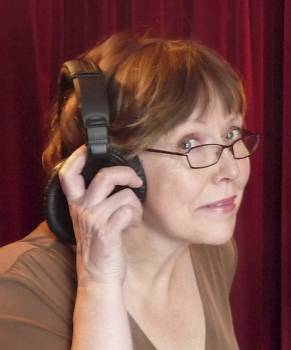 My home studio began with an announcement at the Thanksgiving dinner table a few years ago. My home studio began with an announcement at the Thanksgiving dinner table a few years ago. When I told my family that I had this tender little dream of becoming an audiobook narrator, in the best tradition of well-meaning relatives everywhere, they immediately started expressing their opinions.
I expected objections and cautionary tales, but to my surprise and delight, what I got instead was support.
'HOLMES' STUDIO HELP
First, my boyfriend - an accomplished carpenter - said he’d build my home studio.
Next, one of my nieces and her boyfriend - both trained audio engineers - offered to do the acoustic treatment and teach us to use the equipment and software.
Another niece - an actress - said she’d help me practice.
Finally, my sister - a commercial photographer - volunteered to take promo shots for my website.
HERE WE GO ...
Gulp! Shooting my mouth off was already paying off. Maybe this voice over idea wasn’t so far-fetched after all.
I live in wine country in Northern California. It’s a two-hour commute from my home to San Francisco – the nearest commercial voice over center.
From the beginning, I knew that I’d need my own studio - at least for auditions, if not finished audio tracks.
SHOPPED FOR EQUIPMENT
Following advice received from Edge Studio, I shopped for basic equipment at a music store, where I was able to try things out, and determine what worked best for me.
I’m very glad I did this, because online shopping would not have allowed me to sample the variety of equipment that I did.
For my voice, and my voice over goals, an Audio Technica AT-4050 microphone was the right choice. I particularly like its three settings – cardioid, omnidirectional and figure-eight. (We occasionally record other voice talent and musicians, so it’s nice to have options.)
My headphones are Sennheiser HD 280 pros. I invested in Monster P500 cables, and my interface is a ProTools M-Box2.
THE BEDROOM STUDIO
When I brought everything home, I needed to figure out the best way to set it up in my spare bedroom so that I’d have both
1) a working home recording studio, and
2) a room I could convert to other uses when I needed it.
Plus, I wanted my home studio to be both attractive and functional.
DESIGNING THE STUDIO
My first design idea came in a round-about way – from a bulletin board at the music store.
There, much to my dismay, I discovered that half of the other artists in my area were using the same image on their business cards as I was – a gold microphone in front of red velvet curtains.
I immediately resolved to find a new logo, but rather than throw the baby out with the bathwater, I decided to keep the curtains - literally. Overstock.com had a great price on floor-to-ceiling red velvet drapes.
MOVEABLE 'WALLS'
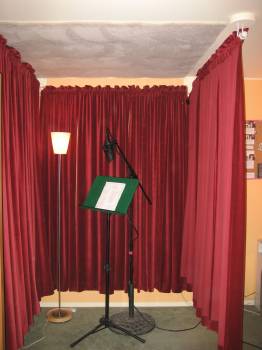 Beginning with these drapes, I designed a four-sided booth. Beginning with these drapes, I designed a four-sided booth.They have moveable sections that swing from the corner of the room to hooks in the center of the ceiling.
My resourceful boyfriend, Fred Campbell, created center and side mounts out of MDF (medium density fiberboard).
It also has swing arms made from standard PVC plumbing fixtures.
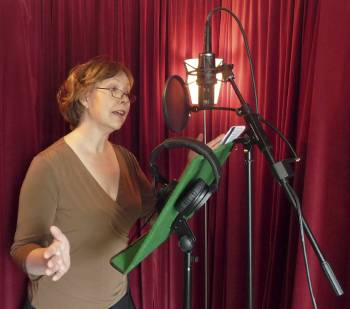 The resulting booth is large enough for me, a copy stand, a mic and mic stand, a chair (for long-form narration), and even several other people when ensemble work is required. The resulting booth is large enough for me, a copy stand, a mic and mic stand, a chair (for long-form narration), and even several other people when ensemble work is required. ACOUSTICS CONTROL
As for other aspects of booth acoustics ...
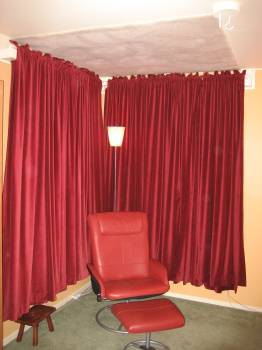 The ceiling was originally covered with acoustic foam squares, but when they started falling off - bonking me on the head while I was performing - I pulled them down, and put carpet on the ceiling instead. The ceiling was originally covered with acoustic foam squares, but when they started falling off - bonking me on the head while I was performing - I pulled them down, and put carpet on the ceiling instead. The entire room has carpet on the floor, so that helps too.
BAFFLE FOR WINDOW
A custom-made baffle fits in the room’s window when a recording session is in progress.
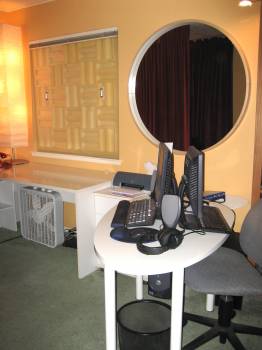 It’s made from a masonite board that separates plain foam on the exterior, which stabilizes the window glass. It’s made from a masonite board that separates plain foam on the exterior, which stabilizes the window glass.There is also acoustic foam in the interior, which baffles room noise.
Two handles ease the placement of this in the window recess.
A curtain over the room’s closet muffles sound and replaces standard sliding doors.
BUT NEEDS VENTILATION
One drawback I’d cite to my home studio design is lack of air flow. So this year’s upgrade will include new ventilation.
I have central air conditioning – essential in my region’s triple-digit summer heat – but it’s not enough.
I turn on a large fan when we take breaks, but I believe the politically-correct term for our summer conditions is “challenging.” (At least, that’s what visiting voice talent called it.)
WATCH THE WIRES!
Another hazard is the sound cables snaking across the floor from the mic in the booth, to the ProTools M-Box.
We’re all very careful, but I’m conscious of the potential for accidents, and always tuck the cables as far out of the line of traffic as possible.
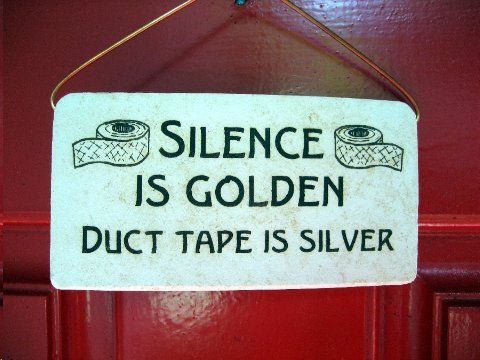 The final flourish on my home studio is the sign I put on the front door when I’m in a recording session. Here, a picture is indeed worth a thousand (unspoken) words. The final flourish on my home studio is the sign I put on the front door when I’m in a recording session. Here, a picture is indeed worth a thousand (unspoken) words. ABOUT ELIZABETH ...
Elizabeth Holmes is voice actor and aspiring audiobook narrator living in Healdsburg, CA.
Email: elizabeth@holmesvoice.com
Web: www.HolmesVoice.com

Your Daily Resource For Voice-Over Success
|
As of the NEW website launch, 03/22/2012




.png)




Ruth Rosen voice actor http://www.allaboutyousongs.com
Nice job!!
What a great article! Thanks so much for sharing the details of your home studio, and congratulations on your gorgeous studio! (And thank you John Florian as well, for printing such an inspiring testimonial to imagination, ingenuity, and passion for voice-overs.)
It’s such a wonderful, satisfying feeling to get our home studio dialed in and have a great place to record our voice-over projects, isn't it? I remember many years ago my first “studio” was my bedroom closet and a $30 Radio Shack microphone! How times have changed. One of the beauties of our voice-over careers is to see the evolution of our studios, as our careers progress. Also, I love how you write as well.
Hope to see more articles from you! xox – Maxine
Great questions!
re: Soundproof blankets... I skipped these for aesthetic reasons. Fortunately, the thick folds of the velvet drapes I used work equally well to deaden sound.
re: Low Rumble & Vibration... Fortunately, this is a rare problem for me. I live in a quiet, rural area. The only rumble I get is an occasional earthquake. (I'm not kidding! :)
Thanks for posting your comments!
Best,
Elizabeth
Thanks!
Jan
Seriously, what did you do to make sure your recording space is soundproof? How do you deal with low rumble noise and vibration? Have you considered using soundproof blankets instead of velvet drapes?